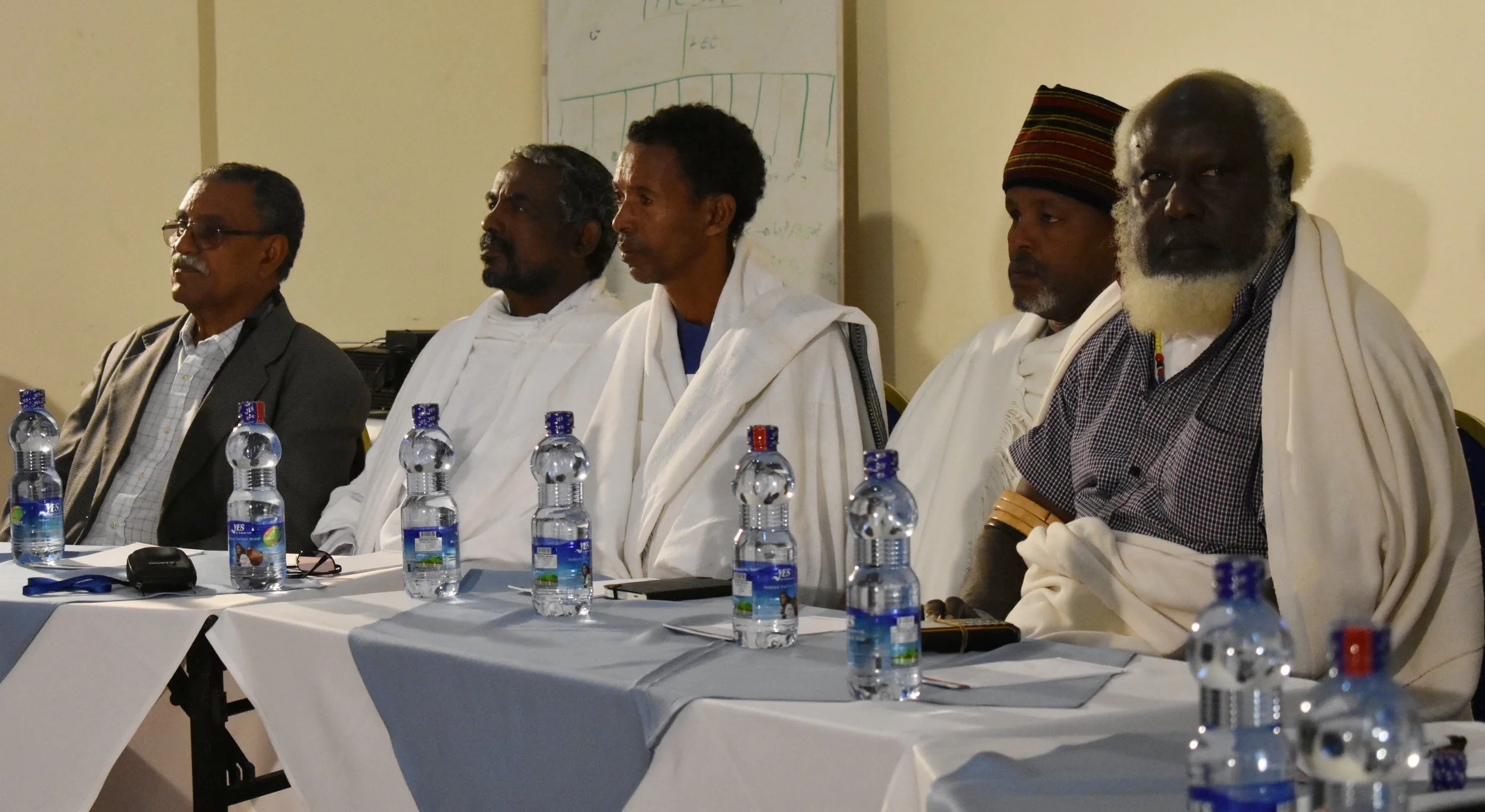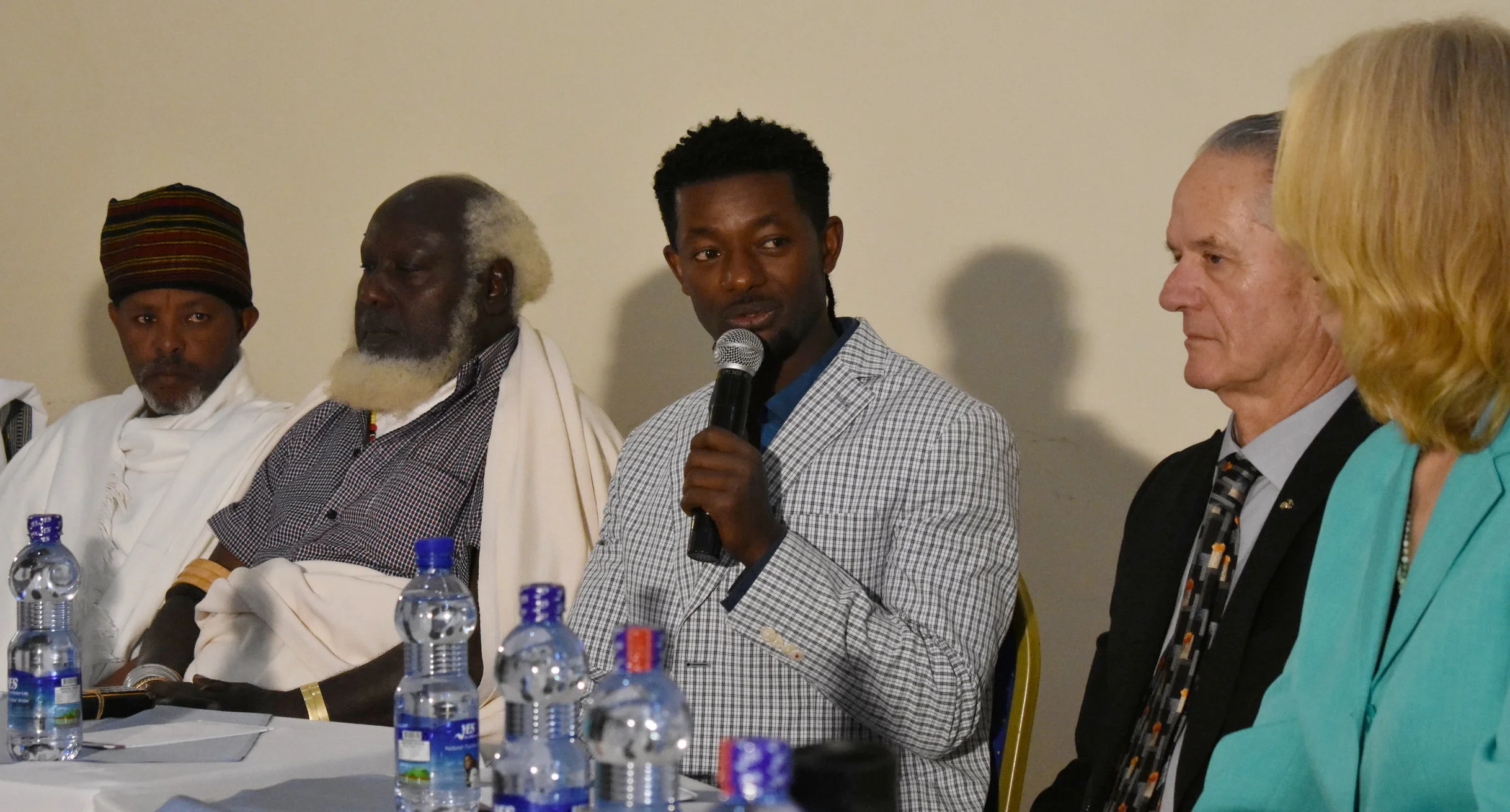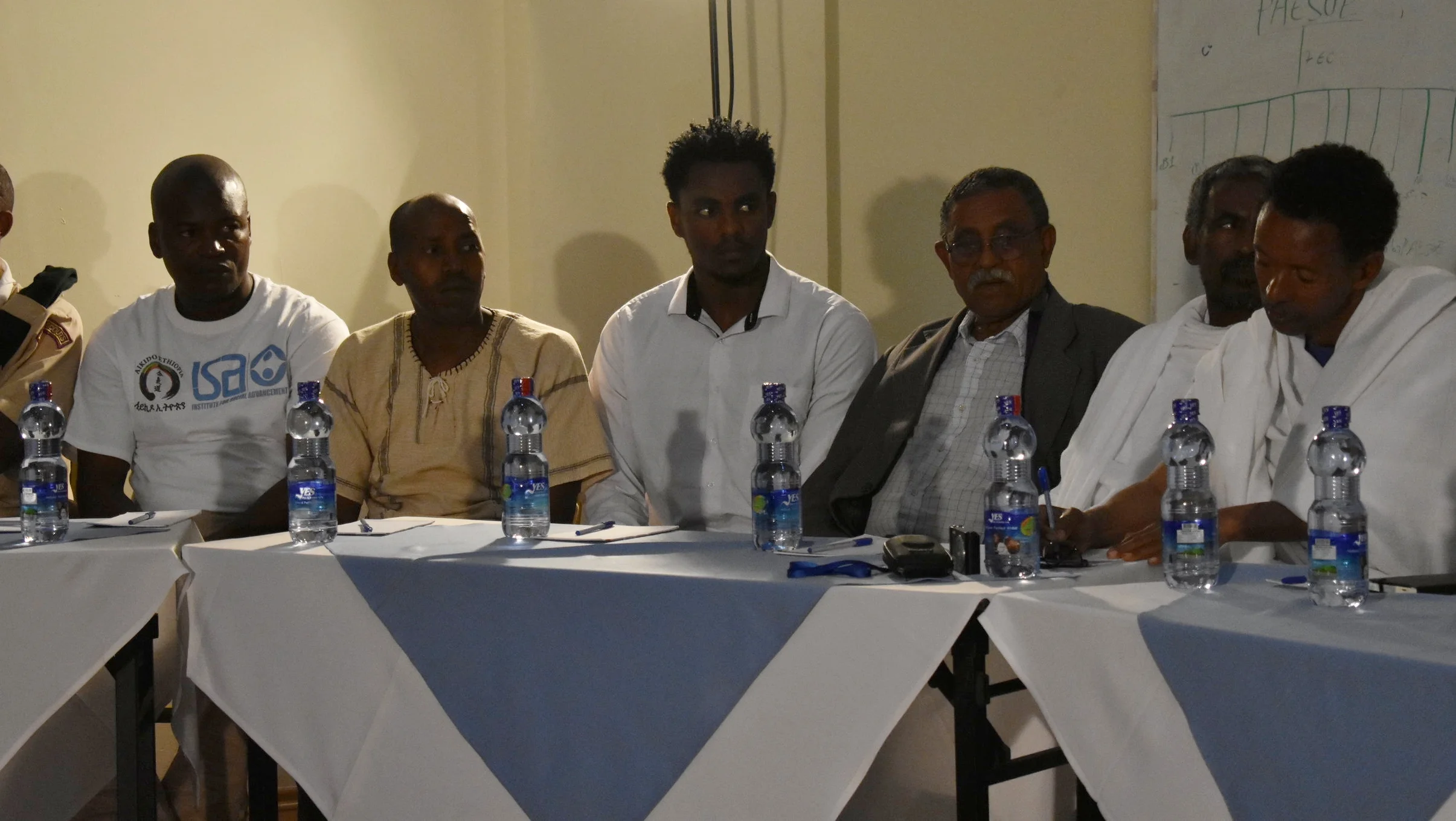The formal Cultural Exchange meeting is held in the large conference room of our hotel. We’ve arranged a semi circle for the Elders, Tes, Linda and myself to sit, and rows of chairs for the seminarians facing us. Tes recommended that the American men wear suits and the women wear long skirts or a pantsuit as a sign of respect and acknowledgement to the Elders, and the formality of the event. The Ethiopians and other Africans aren’t in suits but have clearly upgraded to the next level of finery. Looking around I realize I’ve seen almost all these students with only their gis on and it takes me a moment to recognize them in their “civilian” clothes. Their bright, eager faces beam expectantly. Their expressions clearly show that training aikido with the Elders of the major tribes present is something they probably never imagined, and now it is unfolding before them; there is awe, curiosity, and hope radiating from them. A film crew is busy setting up arc lights and cameras to record the event to be made into a film, as well as sent to the Ethiopian television studios for distribution. The room begins to fill with a quiet, electric anticipation.
Without announcement the Elders enter the room and everyone comes to their feet and begin clapping in unison. They are stately and elegant in their tribal robes. Abu Geda from the Oromo tribe blesses the event with his deep baritone. His voice is somewhere between a bark and a growl that rumbles out of some deep, ancient cavern. It’s like a powerful wave cascading through the room, the incantation taking hold of my body like a rough friend hugging me.
We all sit and Tes welcomes everyone speaking first in Amharic and then English, the translators translating simultaneously in Swahili and Oromo. Highlighting important events Tes tells how it all began when Don Levine introduced him to aikido at the Hawassa Youth Center; his first time out of Ethiopia flying to Nicosia, Cyprus for the Training Across Borders seminar where he and I met; arriving at Two Rock Dojo as uchi deshi (live-in student) where he earned his shodan and also attended the courses in Embodied Leadership at Strozzi Institute; his return to Ethiopia to open up dojos; my visit to Ethiopia two years ago to teach and promote six shodans and four first degree brown belts; Tes subsequently returning to Two Rock Dojo earning his nidan and sandan; his work developing eleven active Dojos in Ethiopia and more. When he announces that three days ago Aikido Ethiopia received the official stamp of registration from the government, the crowd erupts in jubilant shouts and applause. Tes’ story is an exhilarating ride through the last twelve years of Aikido Ethiopia history. Each section evokes particular images and memories and I feel grateful to be part of this social movement. So much has occurred in the last thirteen years and I am privileged to be a participant and to have developed this relationship, this musubi, with Tes, and the aikidoka of Ethiopia. In some ways it seems like a blink of the eye, other times I feel the granularity of it in my bones, a long and sweeping passage through a landscape that is still being traveled.
I stand and tell the story of O Sensei, the founder of Aikido, and how his spiritual awakening turned a powerful martial lineage into an instrument of peace. His declaration “…budo is to bring people together, not to destroy each other” is an ambitious proclamation that is entirely relevant in the 21st century for individuals, organizations, and nations. I then speak about the foundational principles that are learned through the practice of aikido. Yes, it is a powerful martial art in which we learn to defend ourselves, and to defend those who are unable to defend themselves. And, perhaps even more important is that we are developing an alternative response to our instinctual reactions of fighting, fleeing, freezing, or disassociating when threatened. This alternative is called blending in aikido or musubi: tying in with our partner so that their aggression can be neutralized without harming the aggressor. I then demonstrate this with tai no henko, or blending practice, with Tes. By practicing this principle somatically it will be embodied and therefore available to us in the social, interpersonal, conversational space. In other words it’s possible, through aiki practices, to create a society that has alternatives to conflict that are not violence, war, or being in full submission. By acknowledging and listening deeply to the concerns and realities of others we open alternatives to fighting and hostility.
At this point the Elders speak. One at a time they describe how their tribes have traditionally dealt with conflict. It’s a rich, complex heritage that goes back to ancient Abyssinia. As they speak I look into the rapt faces of the audience. Once again I realize what a significant, historical moment this is for these young Ethiopians. For the first time they see these Elders and their representatives in the same place at the same time, sitting together having a civil, sincere conversation about alternative ways to resolve conflict. How simple this sounds-and it is-yet for this moment and for these young people it’s a reality that they’ve never thought possible. They’ve lived their entire lives with armed strife in their country and never thought that these Elders would sit together in a setting like this. I can’t imagine what they’re thinking or how they’re processing what they see or what is being said. What I do see is an intense focus, their bodies rapt, leaning forward with an open-heartedness. I remind myself that for them to simply have this image enter into their psyche has the possibility of opening new doors.
Here are a few of the points of the conversations and questions and answers from the audience:
Before resolving the conflict “the blood must dry first”. That is, end the bloodshed first. No reprisals, revenge, payback or solutions until there is restorative justice and healing.
The transgressor will have to leave the village and/or tribe. In a collective society this is a serious ban. The exclusion itself is a sentencing. Until there is justice they do not have any of the benefits of the tribe. This banishment also has the consequences of the threat of wild animals and opposing tribes if they are in the bush.
At some point the transgressor and the victims come together and the transgressor will take accountability for his/her actions and say what new actions need to be taken. The victims will choose to forgive the transgressor, or not, and ask for the reparations they require. Often an animal, a sheep or goat, will be cut and the blood will fall onto the ground. The victim and the transgressor will step over the line of blood as a symbolic gesture that no more blood or crime needs to occur.
The Elders all agree that this seminar is a good start in reconciling differences, but at this point it’s like a teaspoon from the depths of the ocean. We have to continue and to go deeper and sustain what is initiated here.
One elder from Amhara in giving an example of resolving conflict used the example of two men having a conflict around choosing the same woman. Rudy who had just earned her nidan rank a few days ago asked, “Are you saying that the woman doesn’t have the choice of what man she can pick?” The oxygen seemed to be sucked out of the room followed by a deep hush. Knowing we had landed on a contemporary and controversial subject there was a deep out breath and everyone turned to the Elders. Then an Amhara Elder replied in a grounded, centered manner that it used to be that women didn’t used to have these rights but now it is changing. Furthermore, they were actively engaged in this issue and his example was something from the past.
A young woman who had just earned her first degree brown belt and a third year medical student asked, “How do you think we are doing? Are you proud of us? What do you think of this generation?” An Elder from Tigray replied immediately “I give you 75% approval and 25% not so good.” Almost immediately an Elder from Amhara reached for the microphone and said, “I say 50/50. I approve of your thinking and outlook but I’m very concerned because you always have machines (cell phones and computers) in your hands and the way you dress is separating you more and more from the earth. This is a problem.”
The Elders asked the audience, “Tell us what you need. Remember we need to learn from you as well. Our leadership comes from listening to you.”
Alan Vann Gardner asked what advise they have for westerners in developing Elders in our society. The Elders then outlined the path of becoming an Elder. Based on the ethnic group there is a path for women and one for men. Tribes have different processes based on their own system. For example in some tribes one can become an elder based on his/her wisdom and how he/she lives his/her life. The way they treat people will be the deciding factor to identify him/her to mediate disputes and represent the society. In other systems the path of Elderhood takes forty years and every eight years they’re evaluated by the tribe.
The Oromo Elder, called Aba Gada, said it takes 5 stages to become Aba Gada, and at every stage they will be evaluated by other Elders to pass, or not, to the next level. Elders from every tribe will start teaching young people leadership skills at a young age and pass on to them what is required to be an exemplary leader. Every member in the clan has an opportunity to become an Elder but from the beginning they start looking for those who seem gifted in the leadership arts. The Elders will keep vetting the candidates without them knowing. Since not all will become Aba Gada, those that are not elected to go on will become Elders in the stage they just completed; in other words there are full Elders at every stage. Also, even the last one who is nominated can be dismissed right before he becomes Aba Gada if the Elders find out that he has not been fair to his spouse, family or in his tribal life. He then returns to becoming a member of the society.
The rigor, standards, and embodied interdependence that are exacted on this path of Elderhood are impressive. How sound this seems especially when I think of our current leadership that seems more intent about creating divisions in people, generating fear, acting from greed, building fat bank accounts, and saying whatever is needed to hold on to their jobs. It’s the difference between being a politician and being an Elder leader. I’m not romanticizing this perspective but rather see it in sharp, painful contrast to our ways, and imagine what it would take to legitimatize a path of Elder/Leader in which wisdom, compassion, and skillful action are the determining factors.
That evening we had a small intimate dinner with the Elders and their representatives; one of the representatives was Tes’ mother Alemitu Asura. At one point they said, “This is a very important event. This is the first time that we have ever been in the same room together and it’s important that we are talking and we need to keep doing this.“ One Elder from the North pointed across the table to the South Elder, Oromo Aba Gada and said, “There is much that I am learning from you that I will take back to my tribe.” That moment felt like hitting the target dead center. I could feel our team inwardly smiling and thinking about the happy dance we were going to do.
Richard
Take It Easy But Take It




